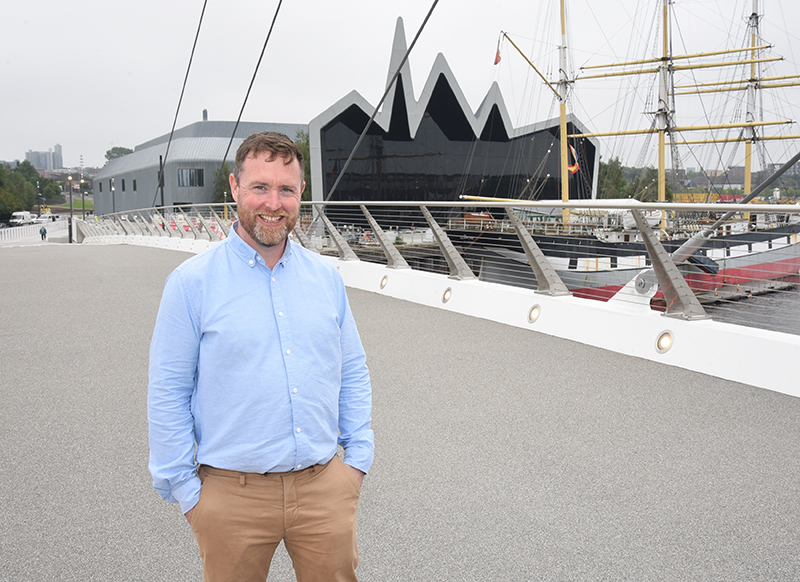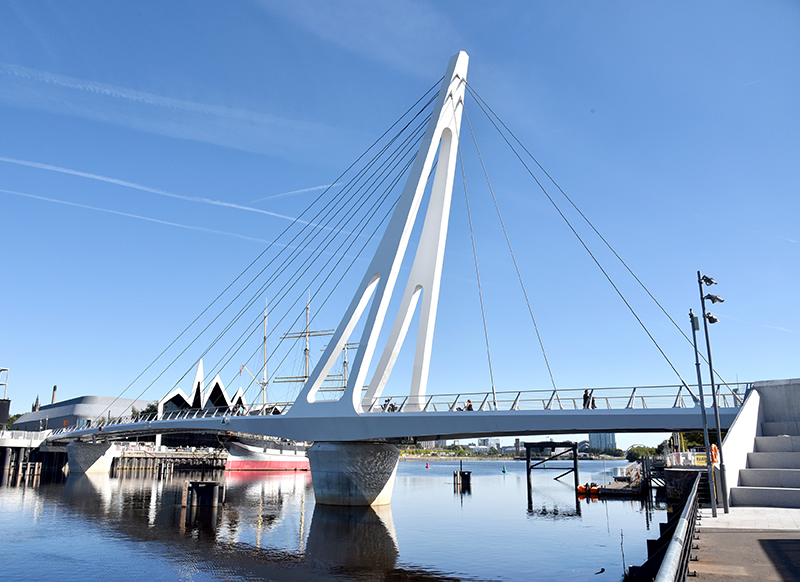
THE project manager on Farrans’ build of the recently opened £29.5 million Govan–Partick footbridge has revealed that forming close ties with the two communities proved pivotal to the success of the delivery of the project.
Measuring 99 metres, the bridge is one of the longest opening pedestrian crossings in Europe and features a moving span weighing 650 tonnes, with the fixed span coming in at 45 tonnes. The bridge restores a historic link between two areas, which is anticipated to deliver a range of economic and social benefits.
Speaking to Project Scotland the day before the crossing’s official opening, which attracted over 6,000 people, David Buchanan revealed that the attitude of those in Govan and Partick to his team proved to be a ‘gift’ when delivering the complex project.
“I don’t think I’ve worked on a project where there’s been that much togetherness and collaboration with the client,” David added. “It’s been faultless and really fulfilling to take a project through like that.”
The relationship between Farrans and the local community was hailed as ‘exceptional’ by judges who handed the firm a Gold Award at the Considerate Constructors Scheme’s (CCS) National Awards in May, with praise also given to the contractor’s ‘excellent’ level of respect for neighbours and ‘strong support’ for local labour, supply chains, and businesses.
Links were established from the get-go of the project in April 2022, with Farrans making regular visits to schools and nurseries, backing existing community groups, launching a range of clubs, and the firm’s community benefit coordinator, Marie Buchanan, providing mentoring to local children.
Site visits were accommodated for students at Glasgow universities, which led to a number of work placements and business owners benefited from weekly breakfast events held at the Riverside Museum, with hopes of creating lasting links that can boost economic growth on both sides of the Clyde.
“It helped us through some of the more challenging times,” David added. “We had people asking questions; they weren’t coming with complaints or negativity – it was all positivity… and I hope in years to come the bridge is going to give the opportunity to continue to spread that positivity to Govan and Partick.”

Perhaps the biggest challenge was the weather, with Project Scotland following the development throughout and experiencing first-hand how exacerbated Glasgow’s typically adverse conditions can become on that stretch of the Clyde.
David previously told Project Scotland how the main span of the bridge had been planned to be transported to site in segments from Belgium before a decision was made to have it constructed and painted entirely in the factory setting. Not only did this reduce the amount of work required over the choppy waters of the Clyde, but its transportation in full resulted in it beating storms which blighted Europe in 2023 and would likely have disrupted multiple transportations.
The south pier had already been built upon the bridge span’s arrival in October 2023. This involved the construction of a reinforced concrete abutment and infilling of the disused Govan ferry inlet at Water Row to form the south landing – with much of the 95 piles being changed to ground bearings to ensure historic structures from the outlet – such as old walls and mooring points – were avoided.
Once the bridge span was in place, construction of the north pier ensued. A 16x16m cofferdam going 12 metres deep into the Clyde was utilised – with it taking two days to pump out the water before digging three metres into the riverbed. The abutment structure was then piled and two months of concrete work followed – including infilling to extend Pointhouse Quay to form the bridge landing, access ramp, and public realm.

“Weather has definitely been one of the biggest challenges,” David continued. “We had contingency measures in place for weather – on the southside we took a lot of the marine works off the Clyde and onto land. On the north side, when in the cofferdam, we were able to relax some of the restrictions that weather would raise.”
Despite these challenges, and the site sitting beside the busy Riverside Museum, Tall Ship and Riverside Festival, no major health and safety incidents were recorded – with CCS judges noting the ‘exceptional’ focus on workforce safety, as well as ‘exemplary’ staff site facilities, and the ‘comprehensive’ mental health programme.
“Safety is always our priority,” David said. “The bridge opening is an amazing achievement for all the project team, but a health and safety incident would’ve taken away from that – it’s a testament to all involved to set the high standards from the project launch and live by those values to project completion and come through it without any accidents on two sites that are small and very confined.”
Bonus points were awarded for the firm’s use of a 360-rotating multi-grab arm attachment on excavators, which limited the amount of manual lifting required on site and also reduced the slew of machines due to the arm’s movable hitch.
“It’s something that has been in the industry a while, and it proved to be very useful on this project,” David explained. “We took it on a trial basis to start with and immediately saw the benefits. Farrans has decided to purchase a few of their own on the back of that trial. It was nice to put it out on the Considerate Constructors Scheme as it raises awareness and might see other sites/contractors adopt it.”
With much of the project team hailing from in and around Glasgow, the grand opening proved to be a special event – with much of the Farrans team joining the large crowds with their families to take in the occasion, which was marked by a festival headlined by the Red Hot Chilli Pipers.
David made Glasgow his home in the early 2000s after moving from Ireland following his graduation from university. Now with children growing up in the city, he revealed how special it will be to take them to the bridge.
“I think being able to say you’ve been able to give back to Glasgow is quite nice. There’s a lot of pride in the bridge; it’s not just steel and concrete – it’s something the project team will be able to talk about with their family for years to come.”










